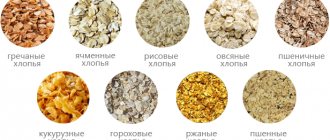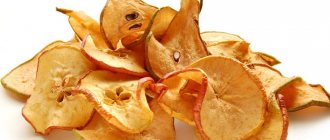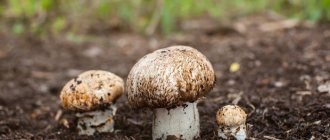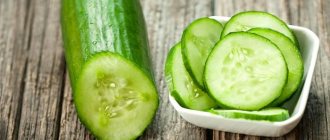Can children have champignons?
One of the most important factors influencing the development of a child is his nutrition, and therefore many parents try to make their child’s diet as healthy and balanced as possible. However, it is often quite difficult to determine whether a particular product is considered healthy or unhealthy food, which raises a lot of questions, for example, can children eat champignons? In this article we will try to find out which group this type of mushroom belongs to, and whether they pose any danger to the health of the little gourmet.
At what age can a child eat champignons?
If you take a serious look at the issue of the safety of champignons for a child’s body and study several sources of information at once, most of them will say that such products are strictly prohibited for children under 7, and sometimes up to 14 years old.
It is usually indicated that by eating even a small amount of such mushrooms, a child runs the risk of developing serious digestive problems, and regular consumption of champignons generally leads to malfunctions in the functioning of the entire body.
In fact, such information is very outdated and completely untrue. Of course, if consumed in excess, champignons can cause some digestive problems, but the same can be said about almost any food.
Of course, each child is individual and it may well happen that such an early introduction will not go too smoothly. That is why, in order to definitely protect your baby from any negative consequences, champignons are added to his menu after two years. By this time, the baby’s digestive system will already be fully functioning and will react normally even to such a difficult-to-digest product.
How many champignons can a baby eat?
Here we should say a few words about how much champignons a child can eat so as not to experience any digestive problems.
- If we are talking about very young children, then they are allowed to eat about 100 grams of champignon soup, no more than 1-2 times a week.
- For five years of age, it is allowed to eat about 50 grams of prepared mushrooms (stewed or boiled).
- Teenage children can eat from 100 to 150 grams of champignons once a day.
The benefits of champignons for children's health
Many parents prefer to play it safe when it comes to feeding their children - even if doctors’ opinions regarding the safety of the product have changed dramatically over the years, they still try not to give it to their child.
This is especially true in cases where the usefulness of food is in question or almost nothing is known about it. It is the second option that is relevant for champignons - everyone knows that such mushrooms are poorly digested, but no one mentions that they are extremely useful, especially if we are talking about benefits for a growing body.
- Champignons are a high-protein food, so eating them can help lower blood cholesterol levels . Thanks to this, the vessels become more elastic and durable, which reduces the risk of developing diseases associated with the cardiovascular system.
- Such mushrooms are an excellent source of such trace elements as iron . It is involved in a lot of processes taking place in our body, but its most important task is to ensure active hematopoiesis. For this reason, regular consumption of champignons promotes better blood production, which prevents anemia.
- Champignons contain linoleic acid . This substance is known for its ability to destroy cancer cells and inhibit their spread. In addition, the systematic intake of this acid into the body can prevent the development of cancer.
- Mushrooms are considered one of the best foods for diabetics because they contain slow-release carbohydrates. When digested, they gradually increase blood sugar levels, which eliminates the possibility of an attack.
- Also, due to the high protein content, champignons help stabilize blood glucose levels , which has a positive effect on the condition of the whole body.
- One of the most important features of champignons is the presence of a large amount of calcium in them . This mineral is extremely important for children, as it is necessary for intensive growth and the construction of new bone tissue. Additionally, calcium strengthens bones and teeth, making them very strong.
- Champignons also contain vitamin D , this substance helps the body better absorb nutritional compounds from food, which leads to an improvement in the condition of all organs and systems in the child’s body.
- Surprisingly, mushrooms can be used as a natural immune booster. The thing is that champignons contain a strong plant antioxidant. It strengthens the immune system and helps it actively remove harmful substances from the body . In addition, the abundance of vitamins in mushrooms further increases the activity of immune cells.
- Champignons are a rich source of such an important trace element as potassium . This mineral is necessary for a person to maintain water-salt balance, since it removes excess fluid from the body. This also reduces blood pressure and reduces the load on the cardiovascular system.
- When describing the benefits of champignons, such a wonderful element as selenium is often overlooked, although in fact it is extremely useful for humans. Consuming foods containing this mineral leads to improved health of hair, skin and nails .
Benefits for the child
High nutritional value and low calorie content, the content of “sunny” vitamin D, potassium, zinc and selenium are beneficial properties of mushrooms for everyone, including children.
- Contains moderate amounts of vitamin D. The best way for a child to get vitamin D is from natural sunlight. But in a modern metropolis this is precisely what is missing.
- A good source of iron, important for the formation of new blood cells. This mineral plays a key role in child development.
- Immunomodulatory properties. Several studies have shown the presence of biochemical substances in mushrooms that strengthen the immune system. As a result, the child's body becomes less susceptible to infections.
- Antioxidant properties are aimed at reducing oxidative stress caused by free radicals in the metabolic process.
- Hepatoprotector. In addition to the benefits mentioned above, mushrooms also protect the liver from damage. During infancy, this vital organ can be attacked by diseases such as jaundice and hepatitis. Scientists believe that some edible mushrooms reduce the concentration of free radicals in liver cells and are useful in the fight against hepatitis B.
Can a child have baby sausages?
Possible harm from eating champignons by a child
So, if champignons are so healthy, then why do experts still recommend limiting their consumption?
The thing is that these wonderful mushrooms bring significant benefits only if the child eats them in small quantities, but if such a product is eaten without moderation, then the risk of various side effects increases significantly.
- The protein contained in champignons is quite difficult to digest, especially if we are talking about a child’s body. Therefore, in case of overeating, side effects such as bloating, pain, flatulence and indigestion are possible.
- There are several varieties of champignons, including forest ones. The main danger of any mushrooms is associated with them - they can easily be confused with a poisonous product. For this very reason, pediatricians strongly do not recommend giving children “wild” mushrooms. It is better to use only artificially grown mushrooms.
- Forest champignons are also dangerous because their quality directly depends on where they grow. So, if the soil has been contaminated, heavy metals are deposited in the champignons, which then enter the child’s body.
- “Home” champignons are grown in soil mixed with manure, which increases the risk of food poisoning. That is why experts advise rinsing each mushroom extremely thoroughly before adding it to the dish.
Harm of mushrooms to children's bodies
The excessive love of mushrooms by many parents often leads to them being included in the diet of very young children. But any pediatrician will tell you that children should not eat mushrooms, and there are reasons for this.
The fact is that mushrooms, despite all their positive properties, are heavy proteins. So severe that the children's gastrointestinal tract is simply not able to cope with it.
Important!
Even the highest quality and environmentally friendly representatives of this product can cause serious gastrointestinal upset in children. And their frequent, or, even more so, regular consumption by young children can cause serious pathologies in the baby’s digestive system.
Another reason why this product is not recommended for children is the presence of chitin in them. This is a hard-to-digest fiber that complicates the functioning of even the gastrointestinal tract of an adult, let alone children! Once in the child's stomach, chitin makes it difficult to absorb other substances that are useful and necessary for the child's body, which means that the possibilities of high-quality formation of the growing organism are called into question.
And the third factor that opposes the consumption of forest products by children is the special structure of their pulp, which works like a natural “sponge”, absorbing all the variety of toxic substances. And it’s good if the mushrooms grew in environmentally friendly conditions, and not along the road... Needless to say, what harm such a “healthy” product will cause to the baby’s body.
Tips for cooking champignon mushrooms for children
In order not to exceed the recommended volume of mushrooms, it is better to add them to other products. For example, for a little gourmet you can prepare risotto with champignons and vegetables or add stewed mushrooms to pasta.
- It is better not to combine mushrooms with meat, especially pork, if we are talking about food for a child. This combination is too difficult to digest and puts a lot of stress on the digestive system. As a last resort, you can add chicken breast to the champignons.
- Be sure to boil the mushrooms well, because only in this form will they be safe for your child and will not cause digestive problems.
- It is better to give dishes with champignons in the first half of the day - heavy food eaten late in the evening can lead to problems with sleep in a child.
As you can see, the answer to the question of whether children can have champignons turned out to be not as obvious as expected. These wonderful mushrooms fit perfectly into the diet of even very young children and complement it perfectly, bringing many benefits to the child’s health.
How to choose champignons for a children's menu?
Children should only be given mushrooms from the store, since such champignons do not absorb harmful compounds from the soil, like wild ones. Buy small, light-colored mushrooms for baby food. Avoid buying champignons that are darkened, slippery or flabby. You should also not purchase mushrooms that are too large, as they are overripe and contain fewer nutrients.
If you buy packaged mushrooms, carefully study the information on the packaging - the date the champignons were harvested, the date they were packaged, and the expiration date. When you bring the mushrooms home, be sure to remove them from the film and store them in the refrigerator for a maximum of 24 hours. If you are not going to cook anything with them right away, you can put the champignons in the freezer, where they can be stored for up to 1 year.
At what age can you give mushrooms to a child?
Despite the fact that mushrooms occupy an important place in the diet, due to their nutritional value, many adults cannot answer the question at what age can mushrooms be given to a child. Doctors and nutrition experts say that offering mushrooms to children 4-5 years old is strictly prohibited, and there are a number of justified reasons for this.
- Mushrooms contain a substance called chitin, which significantly complicates the process of digesting food even for an adult, not to mention a small child of 4-5 years old. The presence of chitin also has a bad effect on the absorption of vitamins contained in mushrooms.
- Another reason is that any edible mushroom absorbs harmful substances present in the environment. That is why it is not recommended to collect mushrooms near busy highways, factories and other industrial enterprises.
But you shouldn’t get upset ahead of time and worry that your child will never try the gifts of the forest. You should be careful when it comes to wild mushrooms that have grown without human intervention. But now the cultivation of mushrooms is widely developed in the conditions of mushroom farms, where the most favorable conditions are created, the necessary atmosphere is created and the influence of a harmful environment is excluded. Most often, oyster mushrooms and champignons are grown in such conditions. Based on this, experts recommend that parents offer mushrooms to their children according to the following scheme:
From two to five years . This is the age when parents can offer their baby mushrooms grown on special farms under control (most often champignons and oyster mushrooms). But do not serve them as a separate dish; it is best to make light mushroom soup.
From five to seven years old . You can add “noble” mushrooms - porcini, aspen and boletus, but also as part of the main dish, as a sauce or gravy for a side dish.
From seven to ten years . It is allowed to add mushrooms to pies and meat dishes. But you need to keep in mind that this is a dish for children, so the amount of mushrooms should be minimal.
From ten to 12 years . The digestive system is already fully formed, so mushrooms can be offered as an independent dish.
Don't give mushrooms often. Once or twice a month will be enough. Starting from 12 years of age, more often - once every 7-10 days. More frequent consumption of mushroom dishes can cause gastrointestinal diseases.
Remember that children with diseases of the digestive system are prohibited from eating mushrooms in any form, regardless of age.
Why are mushrooms harmful?
It is well known that mushrooms are a tasty, nutritious and healthy product. But it’s no secret that this forest delicacy can also be poisonous and cause irreparable damage to health.
The mushroom is a kind of detector; it absorbs heavy metal compounds and other substances harmful to the body from the environment. Also, these representatives of forest flora and fauna, even if they are “cultivated,” have a lot of indigestible dietary fiber. And it interferes with the absorption of other beneficial substances.
The second significant “minus” is the presence of chitin in a relatively high concentration. Quite hard chitin, which protects the body of many insects, is not digested in the human stomach, especially in children. It can also be a catalyst for an allergic reaction. For this reason, giving forest gifts to little gourmets is not recommended at all.
At what age can you give your child champignons or oyster mushrooms? It’s best to ask your pediatrician. However, there are general recommendations for introducing this unique product into a child’s diet; we will consider them below.
Most of the nutrients are found in the mushroom cap. Chitin is concentrated in the legs, and they also contain the least amount of useful elements. Mushroom legs should not be used in children's menus.
How to cook mushrooms for children? Pros and cons of eating mushrooms
When adding mushrooms to the menu of a younger or older child, you need to know about the methods of processing them. First, you need to sort the mushrooms, remove those that are wrinkled, have signs of mucus, or have darkened. For baby food, use only the caps; it is better to cut off the stems because they contain more chitin.
You should not offer children fried, pickled or salted mushrooms; it is best to start acquaintance with a light mushroom soup or sauce for a side dish. After your child tries a new dish, observe his reaction. If an allergic reaction or abdominal pain occurs, exclude the product from your diet.
Mushrooms, like any other food product, have advantages and disadvantages. The main advantages include:
- Availability of nutrients (amino acids, plant fibers, vitamins, phosphorus, selenium, potassium, magnesium).
- The large amount of protein (especially in dried form) allows us to call this product “forest meat.”
- The beneficial substances beta-glucans contained in mushrooms strengthen and support the immune system.
- An important advantage of this product is that mushrooms are very tasty, and with their help you can significantly diversify the menu.
What to do in case of poisoning
A child can even become poisoned by completely edible mushrooms if he eats them in large quantities or if they are improperly prepared. Although more often the use of poisonous (false) or conditionally edible mushrooms leads to intoxication.
Having tried one small piece, the child runs the risk of being poisoned, but not critically. Lethargy, mild abdominal pain, dizziness, and nausea may occur. Signs of moderate poisoning include the same symptoms plus profuse salivation, constriction of the pupils, and very severe pain in the abdomen.
Severe poisoning with poisonous mushrooms is characterized by:
- confusion;
- yellowing of the skin;
- painful, incessant vomiting;
- severe weakness;
- headache;
- increase in pressure.
When intoxicated with fly agaric poison, convulsions, changes in pupils, hallucinations, increased sweating, and agitation are added to the described symptoms.
Parents should know how to provide first aid to their child in case of mushroom poisoning
When a child develops such a condition, parents should not panic, but act calmly and competently. First of all, you need to call an ambulance, and while it arrives, try to perform gastric lavage. To do this, the child is allowed to drink as much water as possible and pressed with a finger or the tip of a spoon on the root of the tongue to induce vomiting. After which you will need activated carbon at the rate of 1 tablet per 10 kg of weight.
The baby must be well wrapped and covered with heating pads, because high temperature has a detrimental effect on helvella acid, which provokes severe intoxication. At the same time, the child is given hot sweet tea and a cleansing enema is given. These measures must be carried out before emergency assistance arrives.
Can children have champignons and at what age?
Champignons are well-known mushrooms, with a pleasant taste and not too strong a smell, but it is better to “collect” them in supermarkets, especially if you plan to cook for your child.
Photo: depositphotos.com. Author: zurijeta.
- among wild plants there are species whose poison causes intestinal upset;
- often edible mushrooms become dangerous due to accumulated toxins;
- Pale toadstools and white fly agaric mushrooms are similar to edible champignons, the poison of which is dangerous to humans.
Experienced mushroom pickers know not to put old and wormy specimens in the basket. We must also be careful with young fruiting bodies if they have grown in an inappropriate place: in a city square or park, in an industrial area, near wastewater treatment plants, in a cemetery.
How to distinguish poisonous from edible?
Unlike the poisonous one, the edible champignon changes the color of the flesh when cut to pink (meadow), dark red (forest) or soft yellow (copper).
False champignons turn yellow when pressed on the cap, the cut on the stem first becomes bright yellow, and then turns into an orange or brown tint. The smell of such mushrooms gives off a “pharmacy” feel. If you put them in boiling water, the water will turn yellow and the carbolic “smell” will intensify.
Pale toadstool and white fly agaric are similar to young champignons, but the color of the plates of dangerous doubles is always snow-white, and the sections of the legs do not turn yellow. Signs of toadstool poisoning appear after 2-3 days, when it is no longer possible to help the person. The lethal dose is 1 g of poisonous mushroom per kg of human weight.
Champignons are dangerous when canned at home. Undercooked, unsealed mushrooms, lightly salted mushrooms and marinades with a small amount of vinegar are conditions for the growth of botulism bacteria.
The choice is yours: either take risks, collecting champignons in the forest and clearings, or buy them safely in the store.
Some enthusiasts grow these mushrooms in their summer cottages. The common champignon - the way we see it on the shelves - loves well-fertilized soil. That is why it quickly spreads in pastures and near cowsheds. These unpretentious mushrooms can be obtained under artificial conditions all year round. Back in the 17th century, Parisians learned to grow them in their cellars.
To exist or not, that is the question
Champignons are comparable in amount of protein to meat, eggs and fish. 18 out of 22 amino acids are found in these mushrooms. In terms of calcium and phosphorus content, they are comparable to fish.
The mushroom, like a sponge, absorbs water and substances dissolved in it. Once in the stomach, it works like a brush. Low calorie content and delicious taste help satisfy hunger during a diet.
The ancestors did not know about chitin, which makes up the cell membrane of mushrooms, but they said: “Mushrooms and cucumbers do not live in the stomach.” The fact is that chitin is not digested in the human body, mushroom protein is only partially absorbed, and polysaccharides cleanse the body of waste and toxins.
From what age should you give?
Dr. E. O. Komarovsky believes that dishes from industrially grown mushrooms can be included in the menu of children from 2 years old once a week.
Pediatricians of the classical school do not recommend giving champignons in any form to children under 7 years of age. By this age, the formation of the gastrointestinal tract ends.
White caps in almost all dishes are used not whole, but in chopped form, as components of sauces, gravy, soups and salads. Apparently, gourmets and famous chefs understand that the taste is good, but the benefits are few.
Cultivated
Photo: Depositphotos.com Author: Toomler
Cultivated varieties are grown under artificial conditions. Popular and beloved ones are champignons and oyster mushrooms.
- In the Western world, as in Russia, the bisporus champignon (Agaricus bisporus) is especially loved, or rather, one of its 3 varieties - cream, which is found exclusively in cultivation. A prominent representative is the portobello mushroom - large, with a “meaty” texture, a real favorite of the vegan world.
- Shiitake mushrooms are not very popular here, although in America they are sold in every health food store, and in Japan they are revered as prolonging life. It is not surprising that mothers and fathers abroad often treat their children to these mushrooms. The same fate befell maitake and oyster mushrooms on the Russian food market. To be fair, we note that scientists confirm: the nutritional value of champignons is quite comparable to exotic varieties, and in some cases even superior.
While Russian pediatricians have a unanimous opinion on the inclusion of forest products in children's diets, the same cannot be said about cultivated species. I propose to decide together when it is possible to give mushroom dishes to a child, at what age, based on the opinions of doctors.
- Do not give until 2 years of age - no discrepancies are observed here.
- Brave doctors allow, from the age of 2, at the request of parents, sauces made from industrially grown oyster mushrooms and champignons sold in stores. Thus, the amount of chitin entering the children's body remains at a low level.
- More cautious pediatricians talk about the gradual inclusion of ground mushroom seasonings in children's menus starting from the age of 5, followed by a transition to dishes with finely chopped mushrooms. You can give this food no more than 2 times a month.
- Some doctors recommend starting to expand your child’s diet with oyster mushrooms and champignons by the age of 7 (gradually and in small quantities). Why exactly at 7 years old? It is believed that at this age the formation of the children's digestive system is completed.
- Any doctor will tell you that it is extremely imprudent to include mushroom dishes in any form on the menu of weakened and sick children.
How not to make a mistake in choosing?
Why are champignons, oyster mushrooms, honey mushrooms and shiitake mushrooms cultivated on an industrial scale? Because these are the most unpretentious species of the mushroom kingdom. They can grow almost anywhere. And the quality and safety of the product is determined by the soil on which the mushrooms were grown.
Small size and light color are signs of youth and freshness of champignons. Another good sign: a pink film under a white, cream or pinkish cap (depending on the place of collection). Dark, flabby, slippery mushrooms are life-threatening.
If the products are packaged, look at the date of collection, packaging and expiration date. It is recommended to store in the refrigerator for no more than a day, after first removing it from the plastic packaging. But you can put mushrooms in the freezer and eat them a year later. It is not recommended to store the product for several years, even in deep freezing.
Poisonous and not very
There are more than 250 thousand species of mushrooms on Earth, but some researchers put a more impressive figure - 1.5 million. The simplest classification, understandable to everyone:
- Edible mushrooms do not pose a risk of poisoning even when eaten raw.
- Conditionally edible - dangerous food. They can be eaten only after pre-treatment: soaking in several waters, boiling, etc.
- Inedible - poisonous representatives of the mushroom kingdom. Toadstool poisoning leads to painful death. There is no antidote!
In addition, poisonings from edible species occur every year during the collection season in different regions of Russia. Causes:
- Mushrooms feed by absorbing toxic substances from the environment (from the ground and air): near highways, airports, industrial enterprises, at waste disposal sites from the ground and air. The older the specimen, the more toxins accumulate in its spongy structure.
- Late processing of some species makes them poisonous.
- Errors in processing, storage and preservation turn the mushroom delicacy into a dangerous poison.
Children's recipes
Cream soup
- 500-600 g of young caps;
- bulb;
- small carrots;
- 1 potato;
- sour cream;
- greenery;
- salt.
- Pour 0.5 liters of water into a saucepan and place on the stove.
- Peel the vegetables, chop finely, put in boiling water.
- While the vegetables are boiling, clean the mushrooms, wash them, cut them and add them to the vegetable broth.
- Cook the soup over low heat, remembering to remove the foam.
- When the champignons are ready, remove the pan from the heat and use an immersion blender to grind its contents and add salt to taste.
- Pour into plates, add herbs and sour cream. Serve with croutons.
Children usually really like this soup. But at what age it can be given to a child, you will have to decide for yourself, based on the scattered recommendations of pediatricians mentioned above.
Dishes with champignons for children
Delicious mushrooms such as champignons go well with vegetables, potato or meat dishes. They can be an ingredient in vegetable casseroles, cabbage rolls, omelettes, and soups.
Many adults also love a variety of pastries with mushroom filling, but it is not recommended for children’s menus, since the combination of mushrooms and dough is quite difficult to digest. Offer children pancakes, pizza or champignon pies only from the age of 14.
Cream soup
For this dish, take one onion, one potato and one medium carrot, as well as about 500 g of champignons. The process for preparing the soup will be as follows:
- After pouring 500 ml of water into the pan, place the container on the stove and wait until it boils.
- While the water is heating, peel and chop the vegetables finely, then place them in boiling water.
- After leaving the onions, carrots and potatoes to cook, wash, peel and chop the mushrooms.
- After dipping the champignons into the vegetable broth, simmer the soup until all the ingredients are ready over low heat.
- After removing the pan from the stove, use an immersion blender to puree the soup.
- Salt the finished dish to taste, sprinkle with herbs and season with sour cream. It is delicious served with oven-dried wheat croutons.
Most children like this soup, but it should not be given to a child who has not tried champignons before. Let the baby first get acquainted with mushroom dishes in the form of sauce.
The sauce made from champignons allows you to add a new aroma and pleasant taste to the usual dishes of chicken, potatoes or rice. This recipe is suitable for children over three years old:
- Wash, peel and boil 8-12 small champignons in 500 ml of water.
- Cut one peeled onion and lightly fry in a small amount of vegetable oil, then add to the broth.
- Fry a tablespoon of flour in a dry frying pan. When it acquires a golden hue, add salt and, stirring constantly, pour hot mushroom broth into the fried flour.
- Cook the sauce for about 10 minutes, then remove from heat and add 2 tbsp to the dish. spoons of butter. If desired, you can also add chopped herbs to this mushroom sauce.
What is healthy about mushrooms?
First of all, they have excellent nutritional properties. In terms of protein content, they can be compared to meat. Mushrooms are sometimes called "forest meat".
Mineral composition:
- potassium;
- magnesium;
- zinc;
- vitamins A, C;
- a lot of phosphorus and potassium, even more than in vegetables and fruits;
- oleic and stearic acids (allow you to fight infectious diseases and strengthen the immune defense).
Mushrooms also contain the substance chitin. By the way, chitin is part of the shells and shells of crustaceans. Just imagine how difficult it is to digest such a product, especially for a child’s body.
Types of mushrooms
Mushrooms are divided into forest and grown in an artificial environment. Forest mushrooms are milk mushrooms, honey mushrooms, boletus mushrooms, saffron milk caps, porcini mushrooms. These types of mushrooms ripen in natural conditions, in the grass, in the sun. Of course, such mushrooms are much healthier.
Mushrooms that are grown artificially are the most common type: champignons, oyster mushrooms. The taste, of course, cannot be compared with milk mushrooms or chanterelles, but you don’t have to worry about their purity, since they undergo full quality control.
How often should I serve mushrooms and in what dishes?
A child’s menu should not include a mushroom delicacy more than once a week. Mushrooms should not be combined with dough, that is, it is not recommended to give pies or pancakes with mushrooms to children at all. This is a huge burden on the digestive tract.
We begin to introduce mushrooms as a flavoring additive in the form of sauces and broths. To do this, you need to boil the mushrooms, add a little sour cream, and chop with a blender. If after taking it there is no loose stool or vomiting, or an allergic reaction does not occur, then you can cook mushroom soup. Next, mushrooms can be mixed with vegetables.
Marinated, salted mushrooms are a taboo for children. They contain a large percentage of salt and vinegar, which have an irritating effect on the mucous membrane of the digestive tract. In addition, such mushrooms lose nutritional value.











